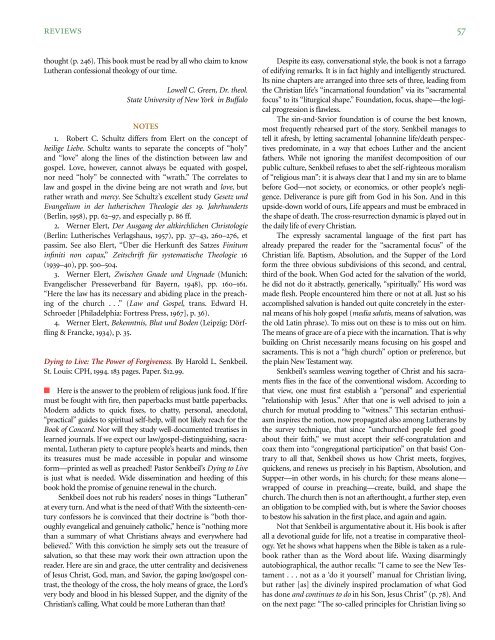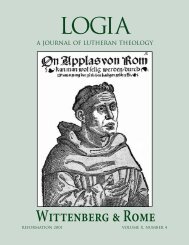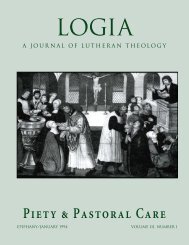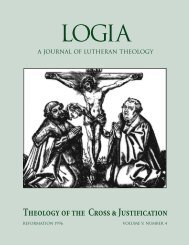04-2 Hermeneutics.pdf
04-2 Hermeneutics.pdf
04-2 Hermeneutics.pdf
- No tags were found...
You also want an ePaper? Increase the reach of your titles
YUMPU automatically turns print PDFs into web optimized ePapers that Google loves.
REVIEWS 57thought (p. 246). This book must be read by all who claim to knowLutheran confessional theology of our time.Lowell C. Green, Dr. theol.State University of New York in BuffaloNOTES1. Robert C. Schultz differs from Elert on the concept ofheilige Liebe. Schultz wants to separate the concepts of “holy”and “love” along the lines of the distinction between law andgospel. Love, however, cannot always be equated with gospel,nor need “holy” be connected with “wrath.” The correlates tolaw and gospel in the divine being are not wrath and love, butrather wrath and mercy. See Schultz’s excellent study Gesetz undEvangelium in der lutherischen Theologie des 19. Jahrhunderts(Berlin, 1958), pp. 62–97, and especially p. 86 ff.2. Werner Elert, Der Ausgang der altkirchlichen Christologie(Berlin: Lutherisches Verlagshaus, 1957), pp. 37–43, 260–276, etpassim. See also Elert, “Über die Herkunft des Satzes Finituminfiniti non capax,” Zeitschrift für systematische Theologie 16(1939–40), pp. 500–5<strong>04</strong>.3. Werner Elert, Zwischen Gnade und Ungnade (Munich:Evangelischer Presseverband für Bayern, 1948), pp. 160–161.“Here the law has its necessary and abiding place in the preachingof the church . . .” (Law and Gospel, trans. Edward H.Schroeder [Philadelphia: Fortress Press, 1967], p. 36).4. Werner Elert, Bekenntnis, Blut und Boden (Leipzig: Dörffling& Francke, 1934), p. 35.Dying to Live: The Power of Forgiveness. By Harold L. Senkbeil.St. Louis: CPH, 1994. 183 pages. Paper. $12.99.■ Here is the answer to the problem of religious junk food. If firemust be fought with fire, then paperbacks must battle paperbacks.Modern addicts to quick fixes, to chatty, personal, anecdotal,“practical” guides to spiritual self-help, will not likely reach for theBook of Concord. Nor will they study well-documented treatises inlearned journals. If we expect our law/gospel-distinguishing, sacramental,Lutheran piety to capture people’s hearts and minds, thenits treasures must be made accessible in popular and winsomeform—printed as well as preached! Pastor Senkbeil’s Dying to Liveis just what is needed. Wide dissemination and heeding of thisbook hold the promise of genuine renewal in the church.Senkbeil does not rub his readers’ noses in things “Lutheran”at every turn. And what is the need of that? With the sixteenth-centuryconfessors he is convinced that their doctrine is “both thoroughlyevangelical and genuinely catholic,” hence is “nothing morethan a summary of what Christians always and everywhere hadbelieved.” With this conviction he simply sets out the treasure ofsalvation, so that these may work their own attraction upon thereader. Here are sin and grace, the utter centrality and decisivenessof Jesus Christ, God, man, and Savior, the gaping law/gospel contrast,the theology of the cross, the holy means of grace, the Lord’svery body and blood in his blessed Supper, and the dignity of theChristian’s calling. What could be more Lutheran than that?Despite its easy, conversational style, the book is not a farragoof edifying remarks. It is in fact highly and intelligently structured.Its nine chapters are arranged into three sets of three, leading fromthe Christian life’s “incarnational foundation” via its “sacramentalfocus” to its “liturgical shape.” Foundation, focus, shape—the logicalprogression is flawless.The sin-and-Savior foundation is of course the best known,most frequently rehearsed part of the story. Senkbeil manages totell it afresh, by letting sacramental Johannine life/death perspectivespredominate, in a way that echoes Luther and the ancientfathers. While not ignoring the manifest decomposition of ourpublic culture, Senkbeil refuses to abet the self-righteous moralismof “religious man”: it is always clear that I and my sin are to blamebefore God—not society, or economics, or other people’s negligence.Deliverance is pure gift from God in his Son. And in thisupside-down world of ours, Life appears and must be embraced inthe shape of death. The cross-resurrection dynamic is played out inthe daily life of every Christian.The expressly sacramental language of the first part hasalready prepared the reader for the “sacramental focus” of theChristian life. Baptism, Absolution, and the Supper of the Lordform the three obvious subdivisions of this second, and central,third of the book. When God acted for the salvation of the world,he did not do it abstractly, generically, “spiritually.” His word wasmade flesh. People encountered him there or not at all. Just so hisaccomplished salvation is handed out quite concretely in the externalmeans of his holy gospel (media salutis, means of salvation, wasthe old Latin phrase). To miss out on these is to miss out on him.The means of grace are of a piece with the incarnation. That is whybuilding on Christ necessarily means focusing on his gospel andsacraments. This is not a “high church” option or preference, butthe plain New Testament way.Senkbeil’s seamless weaving together of Christ and his sacramentsflies in the face of the conventional wisdom. According tothat view, one must first establish a “personal” and experiential“relationship with Jesus.” After that one is well advised to join achurch for mutual prodding to “witness.” This sectarian enthusiasminspires the notion, now propagated also among Lutherans bythe survey technique, that since “unchurched people feel goodabout their faith,” we must accept their self-congratulation andcoax them into “congregational participation” on that basis! Contraryto all that, Senkbeil shows us how Christ meets, forgives,quickens, and renews us precisely in his Baptism, Absolution, andSupper—in other words, in his church; for these means alone—wrapped of course in preaching—create, build, and shape thechurch. The church then is not an afterthought, a further step, evenan obligation to be complied with, but is where the Savior choosesto bestow his salvation in the first place, and again and again.Not that Senkbeil is argumentative about it. His book is afterall a devotional guide for life, not a treatise in comparative theology.Yet he shows what happens when the Bible is taken as a rulebookrather than as the Word about life. Waxing disarminglyautobiographical, the author recalls: “I came to see the New Testament. . . not as a ‘do it yourself’ manual for Christian living,but rather [as] the divinely inspired proclamation of what Godhas done and continues to do in his Son, Jesus Christ” (p. 78). Andon the next page: “The so-called principles for Christian living so
















